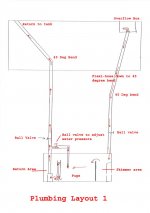Plans for my home made stand are all but confirmed now..that is near enough job done..Next plans are for the plumbing and sump connection..Can you experienced people have a look over my basic drawing of how i think it should work and please give me some feedback..I do accept constructive criticism very good you know..
Remember, its only a basic drawing so far, just want to make sure that i have the principles right before going on to what pump i need etc etc..
Thanks in advance
Niko
Remember, its only a basic drawing so far, just want to make sure that i have the principles right before going on to what pump i need etc etc..
Thanks in advance
Niko










